Archive for the ‘Artists Books’ Category
MARTIN HANSEN MEMORIAL ART AWARDS: Our Works
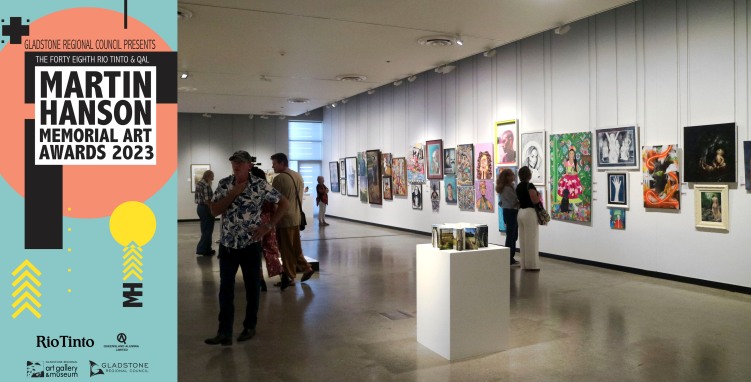
.
Once again we entered the Martin Hansen Memorial Art Awards at the Gladstone Regional Art Gallery and Museum. These Awards are the 48th event – Congratulations to the Gallery Team and the continued recognition of Martin Hanson’s early patronage of artists initiatives in Gladstone through these Awards.
For us each award entered is a place to present new works and their presentation – it is a challenge that hones our skills as artists.
.
This year Victoria’s entry was an artist book entitled String Theory Explained.
.

Victoria COOPER’s String Theory Explained presented
.Artist’s Statement:
String Theory Explained… its all about the unplanned and chaotic nature of everyday life… the beauty and terror within the order of “normal” existence.
.
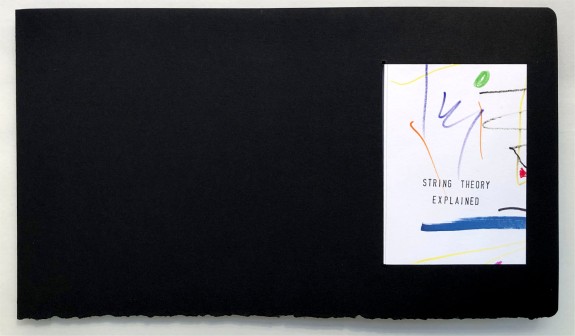
.
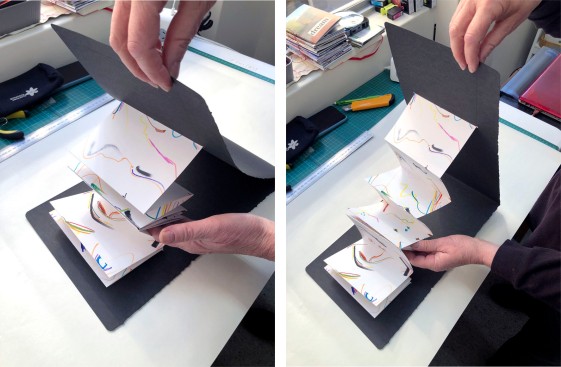
Opening up the book
.
Bibliographic Details:
Format: Concertina book embedded in folded cover
Media: various pen inks on art paper with Stonehenge black cover
Size: 764 x 230mm
.
.
Doug’s entry this year was Story Trees – First Nations a concertina artists book presented in a circular form.
.
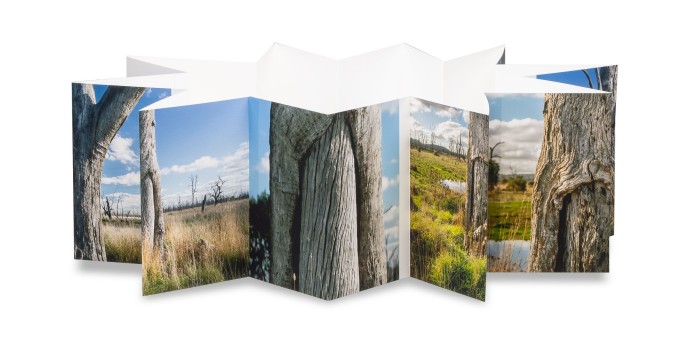
Doug SPOWART – Story Trees artists book
.
Artist’s Statement:
For me a poignant physical sign of First Nations presence remains embedded in the dead trees found throughout Mokoan. In witnessing these scar trees I found a profound sense of a time now passed and thoughts of the many stories that this place can tell.
This book was book two in a series of personal responses to encountering the locality of Mokoan and the Winton Wetlands. It was part of my contribution to the PALIMPSEST collaborative exhibition with Maggie Hollins and Victoria Cooper shown at Bainz Gallery in Wangaratta in August.
.
Bibliographic Details:
Format: Concertina book
Media: Pigment inks on photographic paper
Size in circular presentation: 600 x 700mm
.

Doug’s Story Trees installed at GRAGM
.
.
The Martin Hansen Memorial Art Awards exhibition will be on show until 2.00pm on the 27th of January 2024 at the Gladstone Regional Art Gallery and Museum.
.
Here is some information about the 2023 Awards and the Entry Form.
.
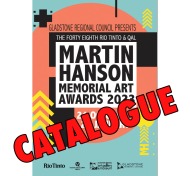 CLICK THIS LINK MH 23 Catalogue Online-r
CLICK THIS LINK MH 23 Catalogue Online-r
.
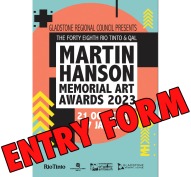 CLICK THIS LINK Martin Hansen Award 2023 Entry Details
CLICK THIS LINK Martin Hansen Award 2023 Entry Details
.
.
Photo of gallery installation courtesy of GRAGM
.
.
.
.
.
.
.
.
HILL END ANALOGUE: Our Cyanotype Works
We are excited to announce that a selection of our Cyaanotype artists books was presented at the Hill End Analogue event.
.
HERE’S THE BACK STORY
Hill End Analogue ( HEA ) is an analogue photographic arts festival presented by Hill End Arts Council Inc. ( HEAC ) in the Central West township of Hill End, N.S.W. HEA
showcased and connected contemporary analogue photographic artists world-wide. The event comprised exhibitions and workshops, the festival engaged with the general community, while promoting contemporary analogue arts and technology.
Hill End is an historic site, managed by N.S.W. National Parks Wildlife Service, and is significant in the history of Australian Photography. The documentation of Hill End and surrounds during the gold boom of the 1870’s by Beaufoy Merlin and Charles Bayliss, forms a large part of the Holtermann Collection in the N.S.W. State Library. Hill End has a thriving arts community, supported by the Bathurst Regional Art Gallery and is closely associated with the National Art School.
(Text modified from the HEA website)
.
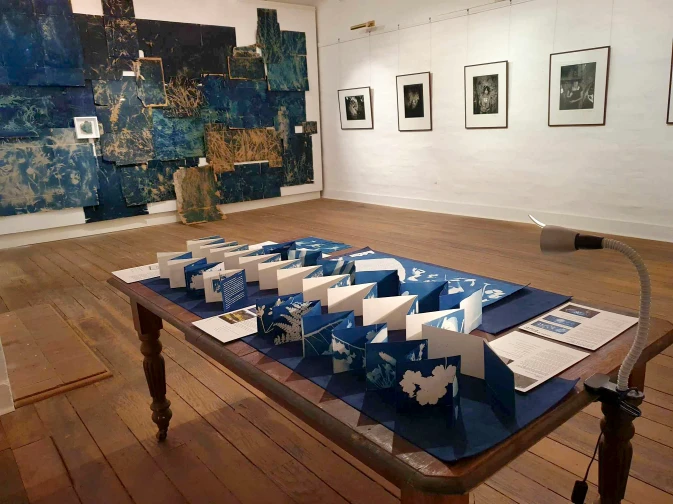
Hill End Analogue Installation PHOTO: Courtesy of Lisa Sharkey
.
OUR CYANOTYPES
.
MORE INFORMATION ON THESE CYANOTYPE WORKS
.
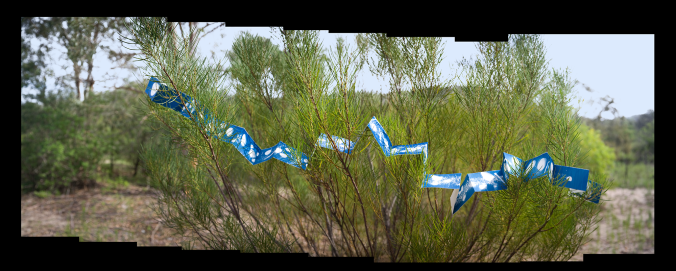
Victoria Cooper’s “Flood” in situ on the island Bundanon
.
FLOOD An artists book by Victoria Cooper
MEDIA: Concertina format with 26 pages, cyanotype on Arches watercolour paper with hand-set type in black ink
Binding by Doug Spowart
SIZE: 10 x 15 x 3cm cm
EDITION: Two unique states
Download a didactic about this book: COOPER – Flood installation at Bundanon
.
.
.
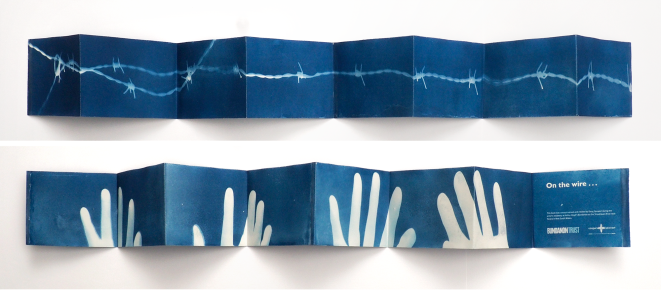
On the wire … A book by Doug Spowart
.
ON THE WIRE … A book by Doug Spowart
A performance based on open-air cyanotype bookmaking directly off subjects in the field.
CREATED: 2007 at Bundanon during an artist in residence
MEDIA: 16 sided concertina format book of double-sided cyanotype images on Arche Aquarelle watercolour paper
SIZE: 11 x 14 x .4 cm – extends to 116 cm
EDITION: Unique state 2 variants
Download a didactic about this book: SPOWART – On the wire – extended recto+verso
.
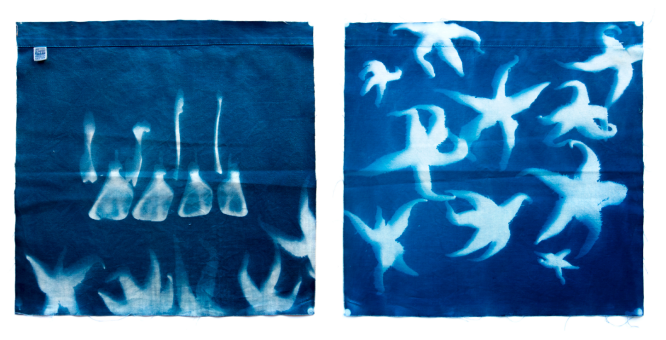
Starfish swarm with wallaby bones by Victoria Cooper
.
STARFISH SWARM WITH WALLABY BONES An artists book by Victoria Cooper
A double-sided cyanotype made from objects gathered in Tasmania. The work was made to celebrate the 2019 World Cyanotype Day.
CREATED: 2019 in Cygnet, Tasmania
MEDIA: Cyanotype on recycled linen pillowcase
SIZE: 30 x 30 cm
EDITION: Unique state
Download a didactic about this book: COOPER-Starfish swarm an wallaby bones
.
.

Roland Barthes an artists book by Doug Spowart
.
ROLAND BARTHES An artists book by Doug Spowart
Roland Barthes the French writer and theorist, has contributed significantly to the discourse and critique of photography. This book is a visual comment on two of his texts.
CREATED: 2017 at Bundanon during an artist in residence
MEDIA: Concertina format with 16 pages, cyanotype on Arches watercolour paper
Binding by Doug Spowart
SIZE: 11 x 14 x .4 cm
EDITION: Two unique states
Download a didactic about this book: Doug SPOWART -Barthes
.
.
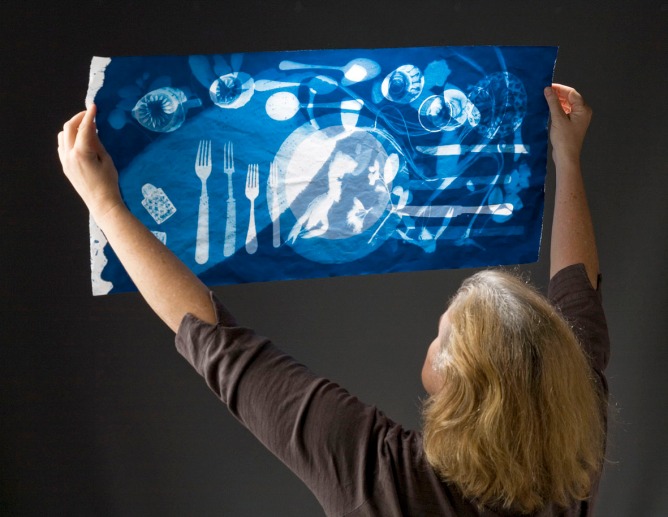
AUSTRALIAN BANQUET: January 26 / 26, 1788 by Cooper+Spowart
.
AUSTRALIAN BANQUET: January 26 / 26, 1788 by Cooper+Spowart
This work reflects on the ‘turning of the page’ in history that Australia Day represents.
CREATED: 2010 on Australia Day in Toowoomba
MEDIA: A unique state double-sided cyanotype on rice paper broadsheet of 7 variants.
SIZE: 37.6 x 77cm
Download a didactic about this book: COOPER+SPOWART – Australian banquet
.
.

PHOTOGRAPHS OF ARTHUR’S GARDEN A book by Doug Spowart
.
PHOTOGRAPHS OF ARTHUR’S GARDEN A book by Doug Spowart
A cyanotype concertina book made on the veranda of Arthur Boyd’s studio during an artist in residence
CREATED: 2007 at Bundanon
MEDIA: 24-sided concertina book. Cyanotype on Arche watercolour paper
SIZE: 11 x 14 x .4 cm – extends to 168 cm
EDITION: Unique state
Download a didactic about this book: SPOWART – Photographs of Arthur’s Garden – extended
..
.
.
.
.
THANKS TO: Lisa Sharkey and the Team for the opportunity to present these works at Hill End Analogue.
The photograph of the HEA installation courtesy of Lisa Sharkey
Text and cyanotype works and photographs © Doug Spowart+Victoria Cooper
.
.
.
.
TONES OF HOME: Cooper+Spowart in group show
.
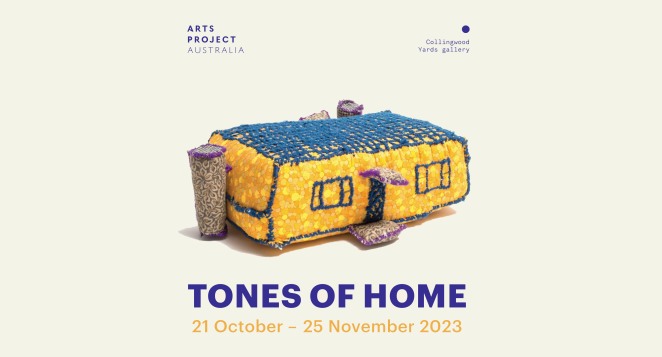
TONES OF HOME – Arts Project Australia
.
Tones of Home draws together artists from Arts Project Australia (APA), Melbourne, regional Victoria, and north Queensland to present works inspired by domestic and urban spaces. Curated by Eric Nash, Director Benalla Art Gallery the exhibition extends beyond these settings to consider ‘what makes a place, a home?’, touching on notions of family, community, belonging, connection, love, comfort, safety, and personal histories.
Featuring APA artists Steven Ajzenberg, Miles Howard-Wilks, Chris Mason, Chris O’Brien, Lisa Reid, Anthony Romagnano, Georgia Szmerling and Amani Tia alongside Atong Atem, Susie Buykx, Cooper+Spowart, Erub Arts Torres Strait and Ghost Net Collective, Aishah Kenton and Ron McBurnie.
(Text from the APA Website)
Tones of Home continues until 25 November 2023
.
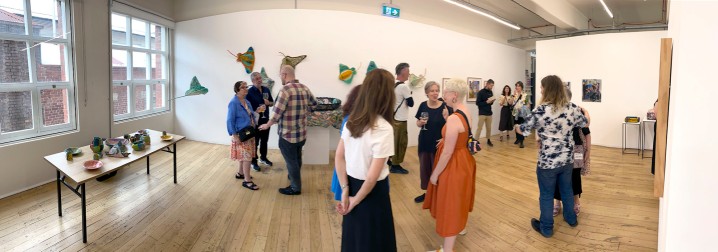
Tones of Home Exhibition
.
SOME COMMENTS FROM THE CURATOR – ERIC NASH
The seeds of this exhibition were truly sewn at home. As my wife and I awaited the arrival of our second child, I found myself considering a work by Mini Graff that hangs above our bed. It is a street art poster in a vintage drawing style. Text on the work reads ‘Today is my lucky washing day’, and a woman hangs washing on a clothesline while an atomic bomb appears to have gone off in the background. It seemed to resonate with my experience of our domestic bubble of safety, and, when at home, perhaps even my ignorance to the outside world.This caused me to ponder what ‘home’ felt like, and indeed meant, to others? It had to mean more than just somewhere we reside. I couldn’t help but imagine my favourite fictional retired barrister, Lawrence Hammill QC, declaring, “You can acquire a house, but you can’t acquire a home”.
I owe a debt of gratitude to the Arts Project Australia team and artists who kicked this project off by sharing their thoughts on the topic of home. A number of responses stuck with me and have framed the exhibition. Home, in their words, could be “where the most important people in your life are”… “where you feel safe”… “a base where you start from”… “a place that fits your ideas of design,
location, and convenience.” Common themes emerged, specifically ‘Personal histories’; ‘Love and family’; ‘Community and connection’; and ‘Belonging, comfort and safety’. …READ MORE FROM THE CURATOR – Download the exhibition Catalogue
“CLICK LINK” TonesOfHomeCatalogue_Web
“CLICK LINK” “Tones-of-Home-Room-Sheet-2
..
SOME VIEWS OF THE EXHIBITION
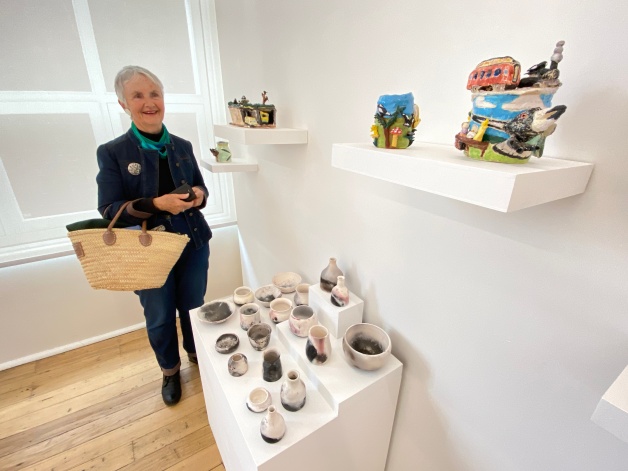
Susie Buykx and her ceramics
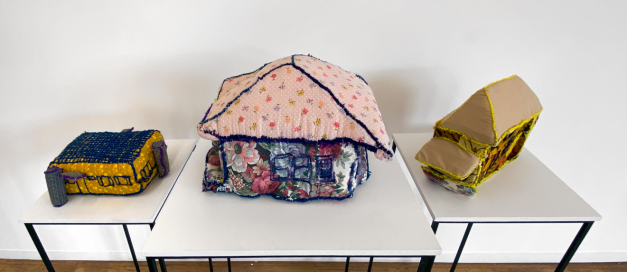
Chris O’Brien’s works
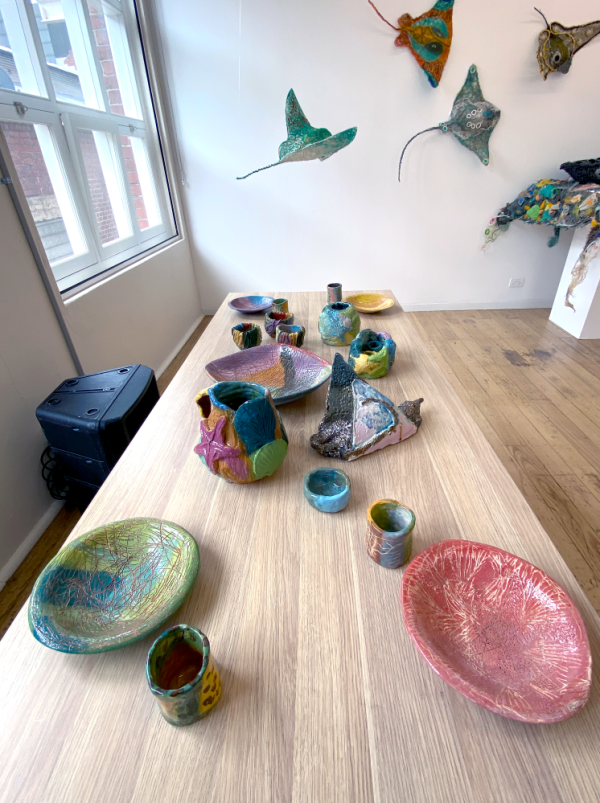
Georgia Szmerling ceramics (front) & Erub Arts Torres Strait and Ghost Net Collective (back wall)
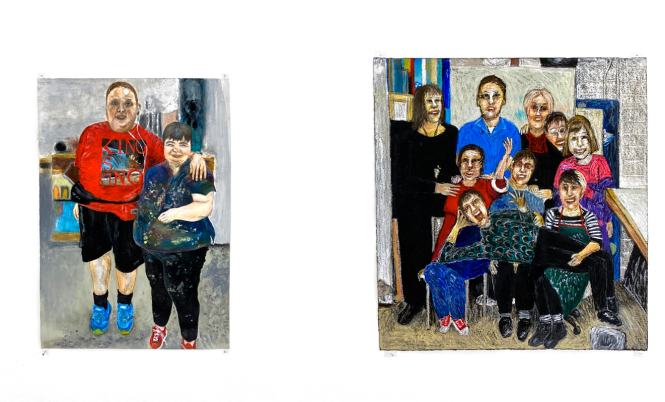
Chris Mason “Me and Monica Together” & “Me and my friends at work” 2019
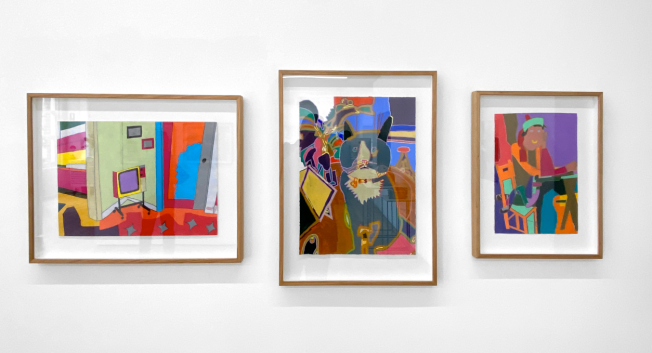
Anthony Romagnano’ works
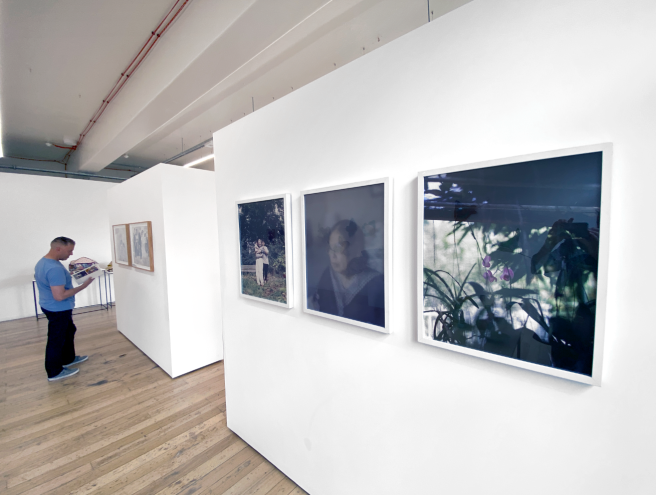
Aishah Kenton’s photographs
.
.
COOPER+SPOWART WORKS IN THE SHOW
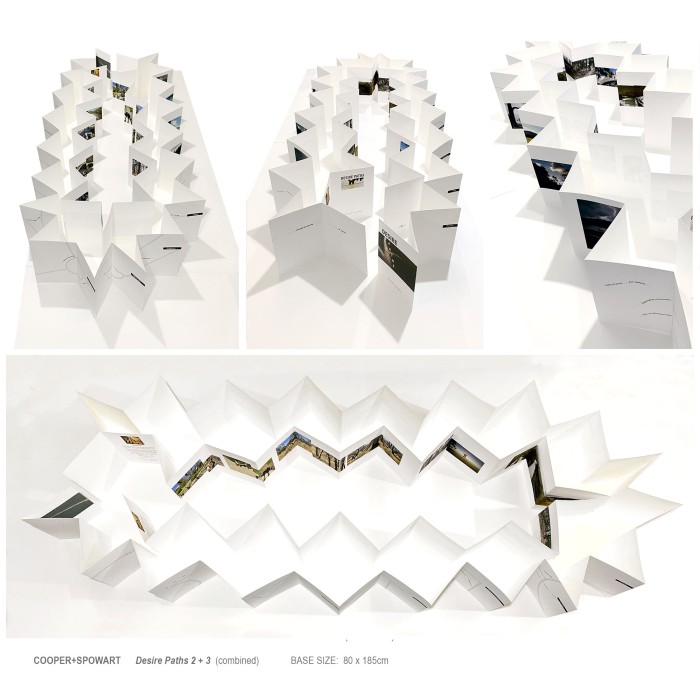
Cooper+Spowart “Desire Paths 2+3” Proposed layout
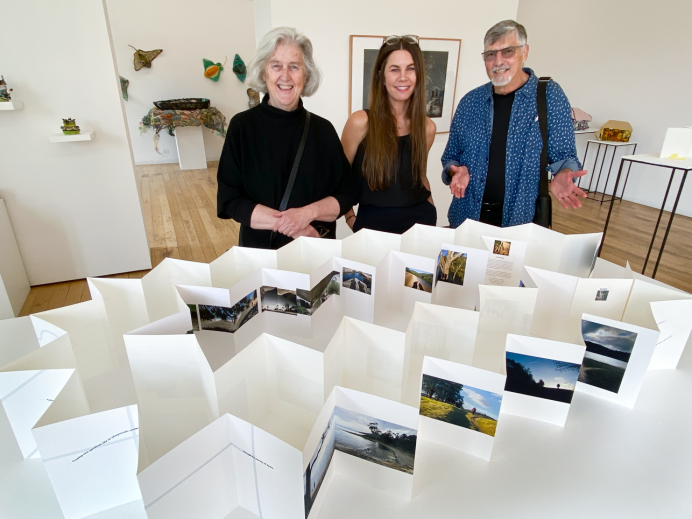
Victoria with Jo Salt Gallery Director + Doug PHOTO: Michael Coyne
C
COMMENTARY ON OUR DESIRE PATHS ARTISTS BOOKS…
Some words from Curator Eric Nash
… I write this essay now during paternity leave. This is the longest time I have spent consistently at home in years. This break and time with Tegan and our children brought something into clear focus: while Tegan and I have moved cities several times in the last ten years, I have always felt ‘at home’ as we have been together. Cooper and Spowart (Victoria Cooper and Doug Spowart) exemplify this through their extensive photography, photobook and artists book practices, which are maintained both as individual practitioners, and as life collaborators. For these artists, ‘home’ “was an idealised state of being in Place, which offered a sanctuary and a garden. More than architecture, ‘home’ is also a psychological and sensorial place for the safe shelter ofmemories and experiences.” (4)
Cooper and Spowart’s recent Desire Paths books resonate with their shared life and artistic journey, explaining “Our artistic process is also defined by the desire to discover new paths around the traditional norms. Over time these new paths become alternative solutions to the ultimate desired outcome. All these paths or lines are theexistential experience and representation of desire.” (5)
1.The astle (1997) Directed by Rob Sitch. [Feature .ilm]. Sydney, NSW, Australia: Roadshow Entertainment.
4 & 5. Cooper, V and Spowart, D (2023) Email to Eric Nash, 27 August.
.
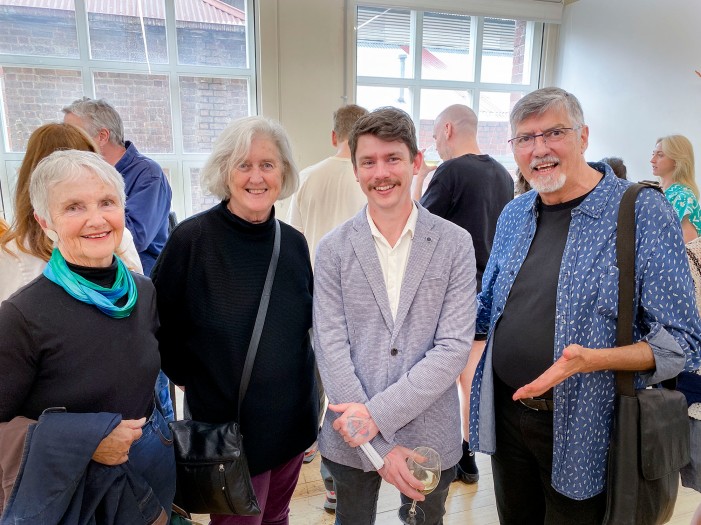
Susie Buykx+Victoria+Eric Nash (Curator) +Doug
.
Thanks to Eric Nash, Jo Salt and the Team at Arts Project Australia for the opportunity to to show work in this exhibition in Melbourne (Naarm). N
.
.
.
Unless noted otherwise photographs are by Doug Spowart
.
.ash
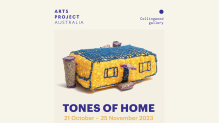
.
.
.
.
.
.
IN THE WETLANDS: 3 Artists – Cooper + Hollins + Spowart collaborate, drawing inspiration from Winton Wetlands
.
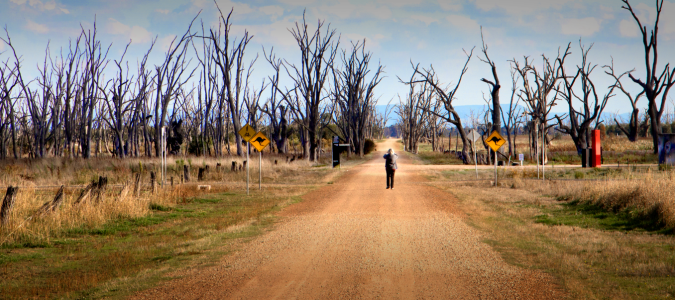
PALIMPSEST Exhibition artists in Winton Wetlands
.
The Winton Wetlands in north-eastern Victoria, also once known as Lake Mokoan, has been through many changes from farming to the building then decommissioning of a dam. Now this visually haunting and beautiful place is undergoing a new phase of regeneration – reviving the natural state of living wetland environment.
.
Dr Lisa Farnsworth, Winton Wetlands Restoration Manager, has been working with local artists to form a group that finds inspiration for their art in the Wetlands. She comments:
.
The Winton Wetlands Creatives Group is driven by a passion for the natural beauty and cultural richness of the Winton Wetlands Reserve. Through various art mediums and engagement opportunities, the group aims to advocate for the Winton Wetlands restoration project and for the ongoing protection and appreciation of its cultural and ecological assets. I’m genuinely excited to see how art, culture and ecology can align to create great outcomes for the health of our local people and natural landscapes.
.
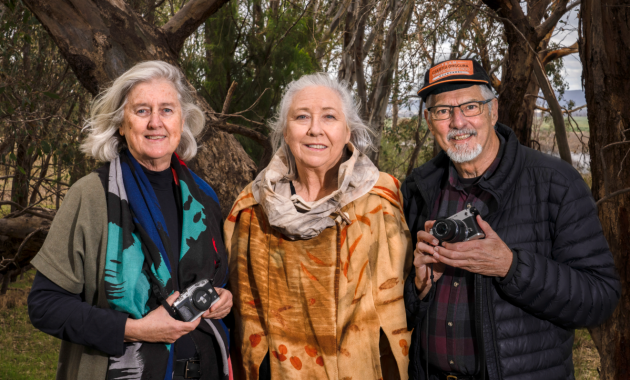
Artists Victoria Cooper, Maggie Hollins + Doug Spowart
.
In the spirit of Lisa’s vision we formed a collaboration with fellow Benalla artist Maggie Hollins to create a visual response to the Winton Wetlands inspired by its layered human and natural history and contemporary renewal. In our work we have associated this altered landscape with the concept of a palimpsest – a manuscript that was reused by writing new text over the previous words.
.
The Palimpsest features again in the exhibition where the collaboration between us as artists can be experienced as a layered narrative, where multiple stories and experiences intertwine to form a cohesive whole.
.
Check out our INSTAGRAM Project picture trail https://www.instagram.com/wetlands.palimpsest/
.
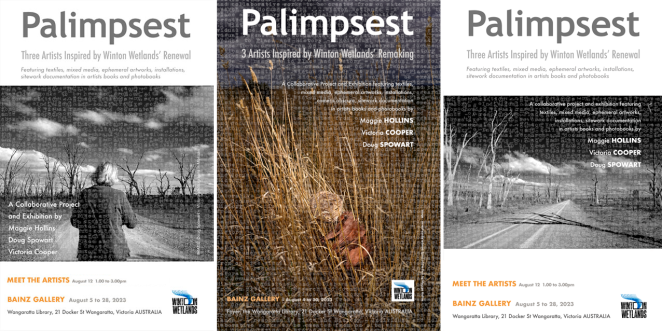
3 Invitations for the exhibition in BAINZ GALLERY in Wangaratta
.
.
SOME VIEWS OF THE EXHIBITION
.
.
SEE A FLY-THROUGH VIDEO OF THE EXHIBITION
.
.
.
A COMMENTARY ON THE EXHIBITION …
Victoria Cooper, Maggie Hollins and Doug Spowart have collaborated to produce and display a wonderful and diverse visual exhibition. They have sought to associate the altered Winton Wetlands landscape with the concept of a palimpsest. In doing so they are contributing to discussion of different, yet overlapping, stories of the wetlands.
Cooper and Spowart have been involved in the arts as practitioners, teachers and commentators for a lengthy time, including having residencies at Bundanon. Hollins has qualifications in ceramics, leads art workshops and enjoys playing fiddle. Unsurprisingly therefore, each and every artwork displayed is of a high standard.
There are unique, handmade textural and sculptural artworks by Hollins that use a diverse variety of materials – including found small branches, knotted bark, dyed cotton thread, solar and rust dyed cotton fabric, metal rings, and found grasses. They are accompanied by postcard sized images of the same artworks “displayed” on site in the wetlands. Those images were a team effort – Hollins operated the camera, Cooper was location scout and camera assistant, and Spowart did the lighting and Director of Photography duties.
There are larger standalone photographic prints and collaborative diptychs by Cooper & Spowart conveying stories of witnessing, magnificent 3 metre wide concertina photobooks by Spowart displayed folded out and attached to the wall, plus artist books and poetry by Cooper.
It all comes together splendidly, successfully conveying the messages the artists want visitors to hear.
.
BRIAN ROPE Reviewer for and member of the Canberra Critics Circle
Read Brian Rope’s full review HERE
.
.
LATER POSTS WILL FEATURE MORE ABOUT THE INDIVIDUAL ARTISTS & THEIR WORKS …
.
.
.
SEE MORE ABOUT THE WINTON WETLANDS …
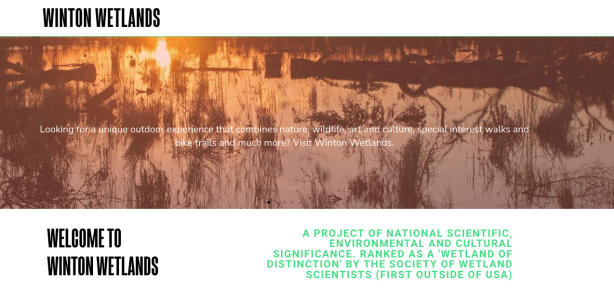
Winton Wetlands website Home page
CLICK HERE FOR THE WINTON WETLAND’S WEBSITE
.
.

Winton Wetlands logo
.
ACKNOWLEDGEMENTS
The artists wish to acknowledge the Winton Wetlands team for their support.
We acknowledge the traditional lands of the Yorta Yorta people & their 8 clans the original owners of Country.
We respect their deep enduring connection to their lands and waterways and recognise that sovereignty was never ceded.
We honour and respect their ancestors, their Elders past, present and emerging.
.
.
.
.
.
JADA 2020: DRAWING on the PHYSICAL & VIRTUAL Exhibition Space
.
The Pandemic and its significant social disruption has reduced the ability for visitors to enter the physical gallery. However the gallery has reached out through Internet mediated platforms to present online formatted exhibitions to not only to those in lockdown just down the street but also to those geographically distanced from the gallery.
This take-up of online exhibitions has been significant that now it seems that every gallery, as well as entrepreneurial artist, have a virtual gallery. Specialist online providers include Matterport, Ortelia Curator and Exhibbit.
.
Some of these online programs can not only give the gallery a record of virtual attendances and where those visitors came from through their ‘hits’ stats, they may even be able to track the way visitors navigate through the online exhibition space. Bravo to the galleries who have stepped up to provide art interested people a 21st century solution to the COVID-19 challenge to provide a connection with commercial or institutional gallery spaces.
.
.
.
At the end of November 2020 after the relaxation of the Pandemic travel restrictions on the Queensland/New South Wales border we visited the Grafton Regional Gallery and the showing of the 2020 Biennial Jacaranda Acquisitive Drawing Award (JADA).
Earlier in lockdown we visited the 2020 JADA quite a few times via their excellent online gallery. On these virtual visits we were presented with an online experience of being ‘in’ the space with enhancements that enabled us to zoom into full size images of the work and through a ‘click’ button, the ability to read the title of the work, artist’s name and other artwork details. While we were online visiting it was interesting to consider that others from all over the country, or even the world, could be simultaneously in the same virtual gallery space.
.
.
SOME OF THE 2020 JADA FACTS
The JADA exhibition presents a snapshot of the contemporary practice of the drawing artform. The 2020 awards presented 56 works from a record total entry of 659. Pre-selection was carried out by Peter Wood (CEO, Arts Northern Rivers), Brett Adlington (Director, Lismore Regional Gallery, Michael Zavros (artist and 2002 JADA winner), and Heather Brown (President, Friends of Grafton Gallery). The judge of the final Award was Peter McKay, curatorial manager Australian Art at the Queensland Art Gallery — Gallery of Modern Art. A catalogue essay was written by Andrew Frost.
.
Teo Treloar’s work titled This is Impermanence (2019) was announced as the winner and Sarah Tomasetti’s work titled Kailash North Face IV (2019) and, Noel McKenna’s work titled Hamlet (2020) were recommended for purchase for the JADA Collection.
.
.
DRAWING ON THE EXPERIENCE OF THE ARTWORKS
The JADA exhibition reveals a myriad of techniques, media and surfaces. The view of the artwork in the physical space of the gallery is a sensory experience that provides an opportunity to encounter the actual art object and the potential for much closer viewing that can reveal so much more about the work.
For that reason my physical experience in viewing the actual work gave me a deeper experience of the media used and the way it contributed to the artist’s communiqué. Now this may sound as if I’m proposing that the physical beats the virtual but that is not my point. The online space is critical to the broad distribution of the artworks in any exhibition. In many ways the viewing of a pixel presented view of an artwork is not dissimilar to how we experience art in the printed form in a magazine or book.
The online exhibition can convey extended information about the art and the exhibition through downloadable catalogues that cover artist’s statements, the judge’s comments and an essay. What I’m highlighting is that the online exhibition plays an important role in connecting viewers with art that is inaccessible for whatever reason. Seeing the physical object in the gallery is an elevated experience. So it is important to note that JADA is a travelling exhibition and that the ability to physically view the works will be afforded thousands of visitors during its 2 year showing.
It is important to applaud the Grafton Regional Gallery for their initiative in organising, hosting the physical show, coordinating the online exhibition and the touring component. For without JADA’s significant biennial review of the discipline in Australia the drawing community of practice could be fragmented and isolated.
My discussions in this Blog post has been in response to seeing the drawing artworks in the gallery space and connect personally with the detail of the mark and its surface. So to share the richness of the close-up physical experience I approached the Gallery to provide me with access to the catalogue and the information it contains. I have now linked this information with close-up images of selected works from photographs* made while I viewed the exhibition. Through this Blog post I’m attempting to extend the virtual viewer’s experience – it may represent a future enhancement to the online gallery.
Enjoy …
Doug Spowart
*Note some of the photographs contain minor reflections of lighting and other frames from the gallery space.
.
.
View our Blog posts on previous JADA 2018 and JADA 2014
.
Download a copy of the JADA 2020 Catalogue 2020 JADA Catalogue
VIEWING THE JADA 2020 IN DETAIL
“CLICK” Image to enlarge

MEDIUM: digital video: chalk, charcoal and acrylic animation on paper, 5:58 minutes (Detail of digital presentation)
VISIT THE ONLINE GALLERY HERE
.
.
.
Thank you to Niomi Sands, Director of the Grafton Regional Gallery and the Gallery team for their support in preparing this Blog post.
In accessing this post please respect the copyrights in the works displayed.
.
.
.
.
COOPER+SPOWART books win ‘works on paper’ Awards
.
THE MARTIN HANSON ART AWARDS
For 45 years the Gladstone Regional Art Gallery & Museum has annually presented the Martin Hanson Memorial Art Awards. The Awards encompass the following art-making areas – easel works, works on paper, three-dimensional & fibre works and digital works. There are three awards for each category and seven special awards including the Pamela Whitlock Memorial Acquisitive Award and the overall Rio Tinto Martin Hanson Memorial Art Award of $15,000. The $40,000 Award prize monies are supported by individuals and community organisations including the Gladstone Regional Council and with significant support from Rio Tinto, Queensland Alumina and other Gladstone mining and industrial businesses.
.
.
ABOUT THE JUDGE: SUE SMITH
Sue Smith is an artist, writer and curator. She has held the position of Art Collection Manager at CQ University Australia since August 2012, after serving for nine years as Director of the Rockhampton Art Gallery and Manager Art Services for the Rockhampton Regional Council.
Ms Smith is an exhibiting artist and her works are held in public and private collections in Australia. She trained in the visual arts at the Queensland College of Art and the CQ TAFE; and studied at the University of Queensland, where she graduated in Art History and Modern and Ancient History.
Her postgraduate studies at the Courtauld Institute of Art, London, were in the History of European art.
ABOUT OUR AWARDED ENTRIES
Over many years we have occasionally entered the Martin Hanson Memorial Awards with previous awards in the ‘works on paper’ category.
Both of the books we entered had been hand-printed and bound earlier in the year and had been finalists in the Artspace Mackay Libris Awards.
Last Saturday evening a friend who had been watching the Awards announcement via ‘Live-stream’ texted us to say “log-on and your names have been mentioned”. So we did and were excited to hear the result first-hand and also the comments from the judges Sue Smith.
.
HERE ARE THE RESULTS
.
THE CREATIVE GLADSTONE REGION Inc AWARD
for the ‘works on paper’ section
went to VICTORIA COOPER for her artists’ book BEING PRESENT
.
Victoria Cooper’s BEING PRESENT
ARTIST’S STATEMENT
Being Present has its physical origins from the Bundanon Trust and the Shoalhaven River.
The electron microscopic images come from unexplored work made during an earlier residence in 2007 of collected detritus from the river. The montages were constructed with these microscopic images as interventions into a riparian environment near the property.
The book is informed by the work of notable writers, thinkers and philosophers, Martin Heidegger and Rachel Carson.
Judge Sue Smith’s comment about the work…
The Creative Gladstone Region Inc. Award
Victoria’s little book is beautifully designed and its semi-abstracted examination of trees and poetic texts asks us to consider wider cosmic questions.
.
.
THE AUSTRALIA PACIFIC LNG AWARD
for the ‘works on paper’ section
went to DOUG SPOWART for his photobook HOME
.
Doug Spowart’s book HOME
ARTIST’S STATEMENT
This book was conceptualised and created during an artist’s residency at Bundanon near Nowra in New South Wales in June 2018. The final design of the book took place in 2019.
For 5 years I have been homeless resulting from the need to travel, seeking work, looking for a place to settle, and maintaining connections with supporting friends and colleagues. The residency enabled inner thoughts to emerge that have been suppressed throughout this time.
Self-imaging is not something new to me. What is new however in this work is the frank reality of the expression, pose and perhaps vulnerability I present in these moments contemplating ‘home’ and what it means to me.
.
Judge Sue Smith’s comment about the work…
Australia Pacific LNG Award
This small book contains a masterly series of photographs contemplating self and the concepts of home and human vunerability, the human figure merging into environmental images that hover between representation and abstraction.
.
OTHER INFORMATION ABOUT THE AWARD
Exhibition Opened – Saturday, 17 October 2020 and Closes – 5pm, Saturday, 30 January 2021
This year’s Art Awards is reaching further into the virtual world, providing an alternate enjoyment experience via Council’s Conversations platform. Artist have been asked to post their profiles online as an accompaniment to their submitted artwork – They can be viewed here:
https://conversations.gladstone.qld.gov.au/projects/45th-martin-hanson-art-awards-2020/artist-profiles
.
After November, in addition to viewing the exhibition at the Gallery & Museum, all artwork entries can be found in the online gallery here: https://conversations.gladstone.qld.gov.au/projects/45th-martin-hanson-art-awards-2020/entries-martin-hanson-memorial-art-show
.
.
.
.
ARTISTS BOOKS+AUSTRALIA: Comment for CODEX Journal
.
Early in 2019 Vicky and I received an email from Monica Oppen and Caren Florance inviting our contribution to a report commenting on news and updates on book arts activity in the Antipodes that they were preparing for the Codex Foundation‘s new journal The Codex Papers. They mentioned that they were asking for those involved with projects, conferences, workshops, collections and awards to send through their comments and plans so the local scene could be collated into the report.
Monica and Caren added that, Your commitment to the photo books and also to documenting events for the past years (or is it decades now?!) has lead us to decide that we must ask you what you see as the trends and key events of the past couple of years. Any feedback (your personal view) on the state of the book arts in Australia at the moment would also be of interest.
We were particularly excited to have been invited to contribute and over the days following the request we collaborated on a document that outlined our view of the scene. Photo documents that we had made were reviewed and prepared and forwarded, along with our text to Monica and Caren. The task of collating and blending the individual responses into a single report was completed and forwarded to the Codex Foundation.
Early this year the report was published and we received a contributor’s copy. We were impressed with the journal and the many interesting commentaries on the book arts from around the world. It was interesting to see the complete report and to read the individual contributor’s comments.
Published below is our text and some of the photographs we contributed in response to Monica and Caren’s invitation.
.
Notes on the Antipodean book arts in the Antipodes for Caren + Monica
.
In the 1990’s and early 2000’s, the world of the artists’ book in Australia was an exciting place. In Brisbane Noreen Grahame, through her Grahame Gallery, Numero Uno Publications, Editions and the Centre of the Artists’ Book championed the Australian artists’ book discipline. Grahame efforts were directed towards artists’ book exhibitions which started in 1991, art book fairs the first of which was held in 1994 and special invitation themed artists’ book exhibitions featuring clique of prominent national book makers.
Artspace Mackay under the directorship of Robert Heather hosted the first of 5 Focus on Artists’ Book (FOAB) Conferences in 2004. Over the years FOAB brought to Australia some of the world’s noteworthy practitioners and commentators on the discipline including Marshall Weber, Keith A Smith and Scott McCarney and juxtaposed them with local key practitioners. For the next 6 years those interested in artists’ books gathered to participate in lectures, workshops, fairs and a solid community of practice developed. In 2006 Artspace Mackay added the Libris Awards: The Australian Artists’ Book Prize that, with a few breaks, continues to be the premier curated artists’ book exhibition and award in Australia.
Queensland also had 10 years of artists’ book exhibitions and 5 years of conferences from 1999-2008 at Noosa Regional Art Gallery. In many ways Queensland was the place to be if you were into artists’ books.
In this period a few other artists’ book awards took place including the Southern Cross University’s Acquisitive Artists’ Book Award from 2005-2011.
Throughout the 1990s and until fairly recent times State Libraries and the National Library of Australia actively collected and built significant artists’ book collections. These included many forms of the artists’ book including: private press publications, significant book works by recognised international and Australian practitioners, books as object/sculpture, zines and the emergent photobook.
Now around the country major libraries are feeling the push by managers to move access to the library’s resources online thus the importance of the physical object and the tactile connection with items such as artists’ books is now not considered part of the service that the institution needs to provide. For example, the State Library of Queensland’s Australian Library of Art, which houses one of the largest artists’ book collections in the country, is now without a dedicated librarian. Research fellowships and seminars that were once administered by the Library and supported the Siganto Foundation are no longer available. Information and advice about the collection and other exhibitions or group viewings of artists’ books from their extensive collection have been significantly affected.
In recent years two Artists Book Brisbane Events coordinated by Dr Tim Mosely at Griffith University has facilitated a significant connection between the American and European scenes with guest speakers like Brad Freeman (Columbia University – Journal of Artists Books), Sarah Bodman (Centre for Fine Print Research – The University of the West of England), Ulrike Stoltz and Uta Schneider (USUS). The conferences also have included a place for discussion and review of the discipline by academics and emergent artist practitioners from Masters and Doctoral programs. These two ABBE conferences have provided a platform for academic discourse.
The artists’ book medium has been principally the realm of the printmaker as their artform easily enabled the production of printed multiples. Digital technologies, new double-sided inkjet papers as well as print-on-demand technologies have enabled the emergence of a range of new self-publishers – particularly photographers.
In 2011 I completed my PhD the title of which was Self-publishing in the digital age: the hybrid photobook. From my experiences in the artists’ book field as a practitioner and commentator and my lifelong activities in photography I saw a future for the photobook which could be informed by the freedoms and the possibilities for the presentation of narratives. While some aspects of this prophecy have been the case with some photographers, particularly those involved in academic study, the main thrust for the contemporary photobook has been towards the collaboration with graphic designers. These books take on various design and structure enhancements including special bindings, foldouts, mixed papers, page sizes, inclusions and loose components that can, at times, dilute the potential power of the simple photographic narrative sequence. The contemporary photobook has developed into its own discipline and through the universal communication possibilities of social media, conferences and awards a new tribe has emerged quite separate from and unaffected by the artists’ book community.
Over the last 5 years the National Gallery of Victoria has presented the Melbourne Art Book Fair. In keeping with the art book fair worldwide movement participants man tables selling their publications. These can range from Institutional/gallery catalogues, trade art publications and monographs, artists’ books, photobooks and zines. The umbrella-like term and the spectacle of the ‘Art Book Fair’ as an event to witness and participate in has captured the individual disciplines and united the various tribes into one, not so homogeneous – community.
A quick review of the 2019 Melbourne Art Book Fair’s 86 table-holders there were only a handful of artists’ book-makers, perhaps a similar number of photobook publishers and a large contingent of zinesters and self-published magazines. The bulk of the tables were held by book distributors, bookshops, arts organisations, educational institutions and art galleries. The discipline of artists’ books was not significantly represented in this space. Was that due to the National Gallery of Victoria’s selection of table-holders or was it to do with artists’ book practitioners not considering the event as a relevant opportunity to show and sell their works?
Ultimately the question is – what is the status of the artists’ book in Australia at this time? My impression is that one of artists’ books key strengths was its closeness to the printmaking discipline and the cohesive bond of makers, critics and commentators, educators, journals, collectors and patrons. As many of these are connected to the tertiary academic environment and collecting libraries, both of which are fighting for their relevance in a changing education and library world, could it be considered that this is a defining moment in the history and the future of the artists’ book in this country?
Doug Spowart co-written with Victoria Cooper
.
.
.
.
All photographs ©Doug Spowart
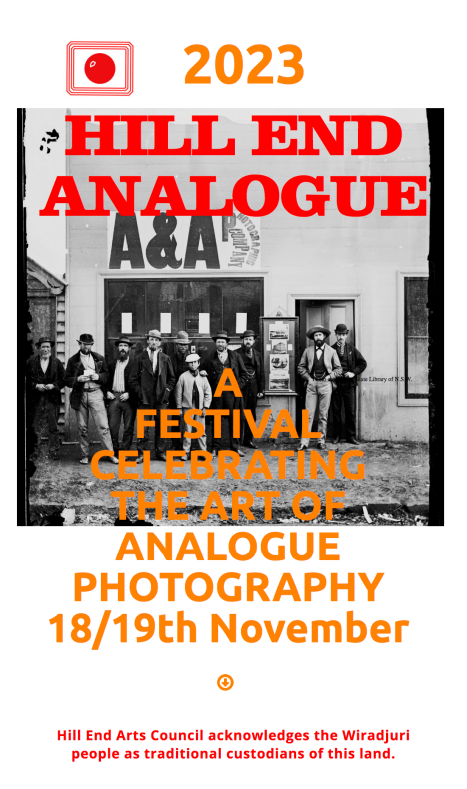







































































































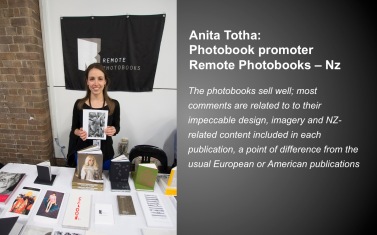





























































































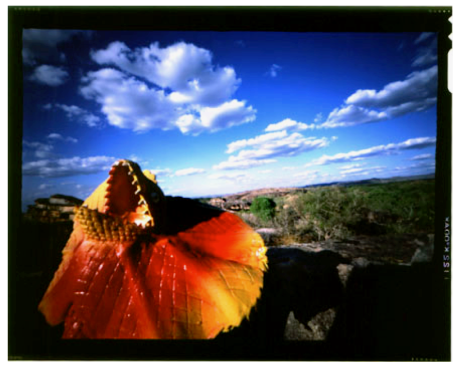


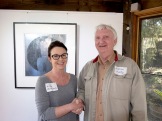













































BRITISH LIBRARY Acquires our cyanotype artists’ book
with 5 comments
A statement about the artwork
Across Australia over the January 26th long weekend, people prepare, cook and consume food to mark this day in history.
For us, this work is our response to, and in recognition of, the ‘turning of the page’ in Australian history that this date represents. One day, January 25th 1788, Aboriginal people feasted on a diverse banquet of bush tucker as they had for thousands of years. The next day, the country was transformed by a new paradigm represented in this work by the table setting of the First Fleet.
Australia Day, for us, is an important time to acknowledge the First Peoples’ perspective and their knowing of land, culture and history and how it should be recognised as underpinning the diversity and identity of contemporary Australia. We, as descendants of European people, are seeking to understand and know more about our place within the longer history of this land.
.
View 1: Australian Banquet, January 25/ 26, 1788
The 25th of January side of the broadsheet is viewed and contemplated.
.
View 2: Australian Banquet, January 25/ 26, 1788
The broadsheet is then turned over to view the 26th of January side.
.
View 3: Australian Banquet, January 25/ 26, 1788
Finally the broadsheet is held up to the light – the complex interrelationship between the two visual references to be seen and considered.
BOOK DESCRIPTION: A unique state artists’ book broadsheet
TITLE: Australian Banquet January 25/26, 1788
MEDIA: Double-sided cyanotype image in rice paper
DIMENSIONS: 37.6 x 77cm
PLACE & DATE MADE: Toowoomba, Queensland, Australia, 2010
EDITION: 7 unique state variants
SOME REFLECTIONS ON THE BOOK’S HISTORY
COLLECTIONS, EXHIBITIONS & AWARDS:
2020 COLLECTION: British Library
2015 EXHIBITED: Books by Artists – The Webb Gallery as part of the Artists Book Brisbane Event, Conference at the Queensland College of Art, Brisbane
2014 EXHIBITED: Artist’s Books (reprised) [artists’ books 1978-2014] – George Paton Gallery, University of Melbourne
2014 EXHIBITED: Alternative Imaging – Curated by Dawne Fahey at Two Doors Gallery, The Rocks, Sydney
2011: COLLECTION: Australian Library of Art, State Library of Queensland
2011 SHORTLISTED: Southern Cross University Artists’ Book Award, Lismore. Judge: Ross Woodrow
2011 EXHIBITED: BLUE – Arts Council Toowoomba members exhibition, Toowoomba Regional Art Gallery
2010 AWARD WINNER: Martin Hanson Awards, Gladstone Regional Art Gallery – Works on Paper
2010 EXHIBITED: Art Bound – Red Gallery, Glebe, Sydney
2010 FINALIST: Josephine Ulrick & Win Schubert Photography Award – Gold Coast City Gallery. Judge: Judy Annear
.
.
.
.
.
Text and © Doug Spowart+Victoria Cooper
.
.
.
.
Share this:
Written by Cooper+Spowart
January 26, 2020 at 1:20 pm
Posted in Artists Books, Cyanotypes, Wot happened on this day
Tagged with 1788, artists' book cyanotype, Australia Day comment, Australia Day in art, colonial Australia, cyanotype, Helen Cole, invasion day, January 25/ 26, View 1: Australian Banquet